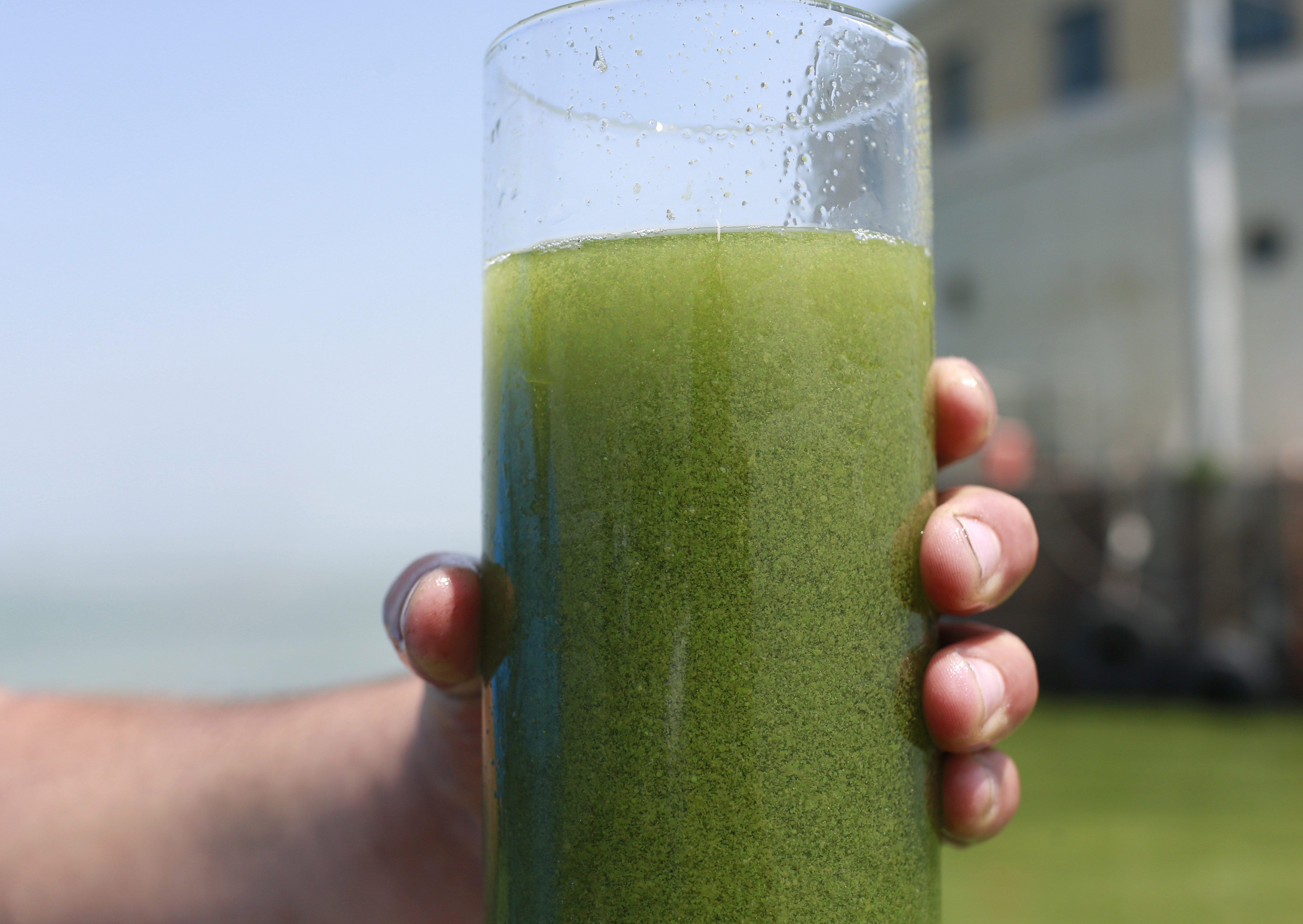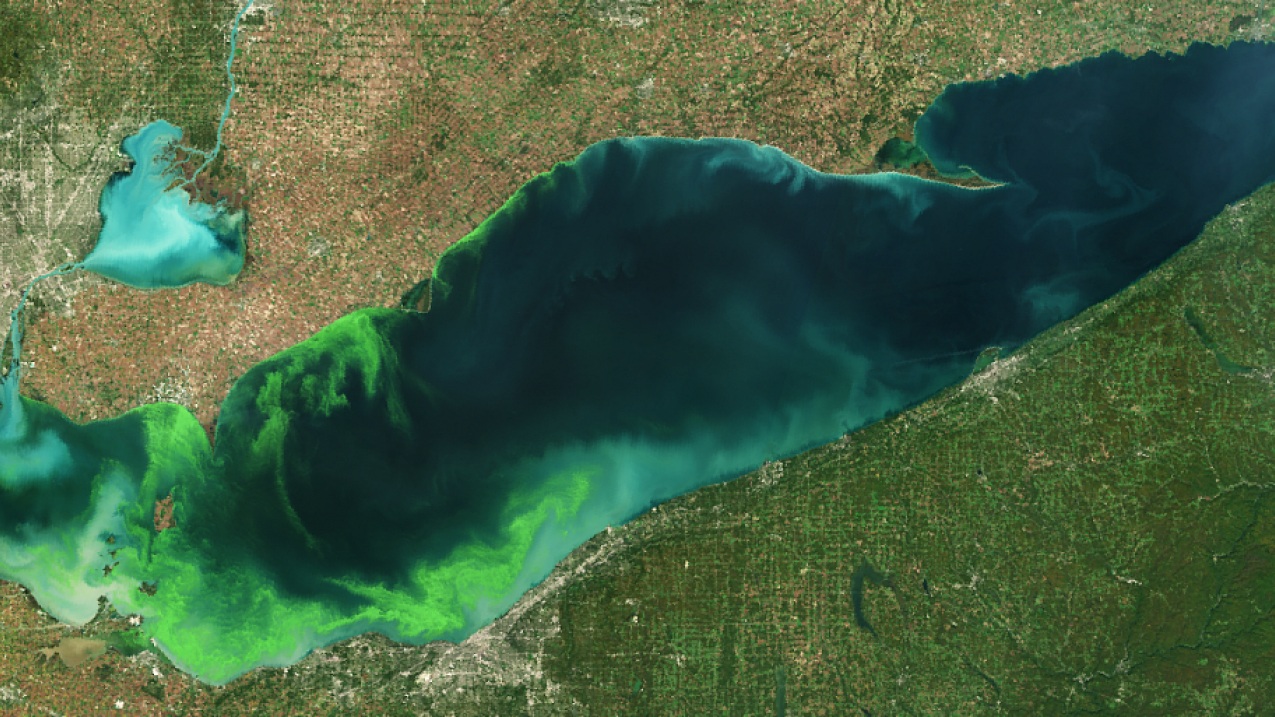On August 2, 2014, the residents of Toledo, Ohio, a port city on the shores of Lake Erie, woke up without clean water. Testing had detected elevated levels of microcystin — a potent liver toxin and possible human carcinogen — in the city’s drinking water supply, and for three days, residents were told not to drink, bathe in, or even touch their tap water. The toxins were traced to a harmful algal bloom, or HAB, a potent green sludge made up of microscopic algae and bacteria that had sprouted in the shallow waters of the lake.
Alicia Smith remembers that day. Nearly half a million people lost access to drinking water, and 110 got sick, experiencing headaches, chest tightness, muscle weakness, and nausea. Smith is the director of the Junction Coalition, a community organization in Toledo that works on promoting environmental justice and economic empowerment for the city’s low-income residents, many of them communities of color. Every August since then, she said, her neighbors worry about whether they’ll lose access to water again as fresh blooms occur.
Beyond the health risks, Toledo residents are paying the price for this ever-present — and growing — threat. According to a report released in May by the nonprofit Alliance for the Great Lakes, the city of Toledo spends, on average, $18.76 per person annually on HAB-related monitoring and treatment, which adds up to nearly $100 for a family of five per year. That cost, generated from data from the Ohio Environmental Protection Agency, is passed on to ratepayers, making water bills even less affordable for many residents, Smith said.
 Aretha Howard carries a case of bottled water to her car in Toledo, Ohio during the water crisis in August 2014.
Aretha Howard carries a case of bottled water to her car in Toledo, Ohio during the water crisis in August 2014.
Paul Sancya/Associated Press
“We as the consumer have the burden of paying for a lack of regulation, mandates, and policies on water contamination,” she told Grist.
The report is one of the first to examine the cost of harmful algal blooms, a yearly problem that’s gotten worse in the last few decades. In the 1960s, before the Clean Water Act set limits on the discharge of pollutants from so-called “point” sources, like wastewater treatment plants, into the Great Lakes, the main cause of algal blooms was untreated sewage — a toxic stew for beach-goers, but a nitrogen-rich snack for algae. Now, though, the main food source for HABs is agricultural runoff — both excess fertilizer and animal waste, which contain phosphorus and nitrogen that flow from “nonpoint” sources like farm fields and are therefore not regulated by the federal Environmental Protection Agency.
This runoff, combined with discharges from combined sewer overflows and warming waters in the shallower parts of the Great Lakes, creates a perfect environment for HABs. Since 2012, the city of Toledo’s public drinking water system has regularly tested the waters of Lake Erie for microcystin. It also monitors the levels of cyanobacteria, which produce microcystin and are a key component of algal blooms, on an hourly basis. But even if an algal bloom isn’t toxic, treating the water and disposing of the waste that’s created still adds an additional cost. These burdens are then passed down to ratepayers, in a region where the rising cost of water has already left thousands of families in debt or facing shutoffs.
“The agribusiness system has relied on the ability to externalize these costs to downstream communities,” said Tom Zimnicki, the Agricultural & Restoration Policy Director for the Alliance for the Great Lakes. “And that clearly is not an equitable system.”
These costs are likely to grow, Zimnicki added, as climate change supercharges the spread of HABs. Severe storms in the Midwest are becoming more frequent and intense; the amount of precipitation falling in the heaviest storms has increased by 35 percent since 1951, according to the University of Michigan. All that precipitation washes more soil — and with it, fertilizer — from agricultural areas into the region’s waterways. In 2020, more than 9,000 metric tons of phosphorus flowed into Lake Erie. And as the climate changes, average temperatures around the Great Lakes are also getting warmer, creating optimal conditions for HABs to develop. Average summer temperatures in Lake Erie’s waters have increased by 1 degree Fahrenheit since 1980.
 Water drawn from Lake Erie, where the city of Toledo sources its drinking water, contained a thick soup of algae and cyanobacteria during the water crisis in 2014.
Water drawn from Lake Erie, where the city of Toledo sources its drinking water, contained a thick soup of algae and cyanobacteria during the water crisis in 2014.
Haraz N. Ghanbari/Associated Press
The issue is also not limited to the Great Lakes Region. In June, the U.S. Government Accountability Office released a report urging federal agencies to do more to address algal blooms, which are occurring in all 50 states in all types of water — fresh, saline, and brackish. The report indicated that different kinds of algal blooms, from “red tides” in Florida to cyanobacteria in Oregon, are burdening communities that rely on waterways for economic activities like tourism and fishing, as well as threatening their health and drinking supplies.
Zimnicki noted that the data for the Alliance for the Great Lakes report was collected in 2020, a relatively mild year for HABs, so the true costs for water treatment and waste disposal are likely higher than what is noted in the report. The organization is advocating for states and municipalities to collect this data more regularly, he said, to be able to compare costs from year to year and see whether they change over time.
This year, thanks to fairly average rainfall in the spring and early summer, scientists don’t expect to see a particularly large algal bloom in western Lake Erie, according to the National Oceanic and Atmospheric Administration’s annual forecast for HABs. Conditions will likely be similar to 2018, when most of the lake remained clear but areas around Toledo and nearby Sandusky, Ohio, experienced persistent blooms throughout the summer. A medium-density bloom had already formed in the area as of July 10, according to NOAA, but forecasts can’t predict how toxic blooms will be, and covering a smaller area could actually make them more concentrated.
Researchers on a call announcing the forecast also warned that the long-term trends are still worrying; the volume of water flowing into Lake Erie from the Maumee River has been above average for 12 of the last 14 years, while the amount of phosphorus entering the lake remains high, despite efforts to reduce it. An agreement signed between the United States and Canada in 2016 aimed to cut the springtime discharge of phosphorus into Lake Erie’s tributaries to 6,000 metric tons per year – but every year since has exceeded that amount.
 Satellite photos of Lake Erie can detect particularly strong algal blooms, such as this one in 2011.
Satellite photos of Lake Erie can detect particularly strong algal blooms, such as this one in 2011.
European Space Agency
Meeting that goal will require reducing fertilizer application as well as increasing the amount of water retained by the land and decreasing soil erosion, Santina Wortman, a physical scientist for the EPA’s Great Lakes office, told reporters on the call in early July. Federal funding for the Great Lakes Restoration Initiative as well as state programs like H2Ohio, which incentivizes farmers to create “nutrient management plans” that use less fertilizer, are steps in the right direction, but these solutions will have to be applied on a large scale in order to be effective, she said.
Silvia Secchi, a natural resource economist at the University of Iowa, however, says the problem runs deeper. The programs implemented so far are mainly voluntary measures, and don’t address the nutrient runoff produced by industrial agricultural operations like large animal feedlots, which generate tons of manure that gets spread on nearby fields as fertilizer. These businesses, Secchi said, have no incentive to change as demand for their products — like cheap pork and beef — keeps rising. The situation was like trying to empty an “ever-growing bucket with a little spoon,” Secchi said.
Smith also wants to see legally binding limits on nutrient pollution, as well as greater investment in green infrastructure to reduce runoff into the Great Lakes. But she emphasized that solutions have to place low-income residents and community members, who face the greatest burden from the cost of dealing with HABs, at the forefront. Aside from laws preventing utilities from shutting off water if customers are unable to pay, she said funding will be needed to distribute water filters, educate people about the harmful effects of HABs, and make water affordable for all residents.
“As the Great Lakes, we live right in the midst of the freshwater,” Smith said. “If you know that water is important, if you know that water is life, then you will preserve just that.”
[ad_2]
Originally Appeared Here